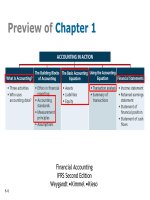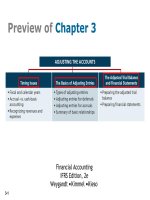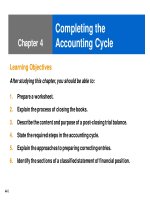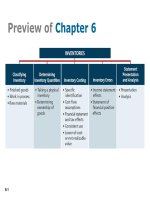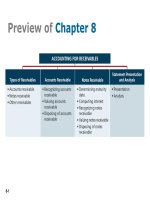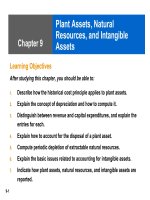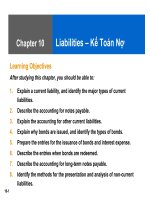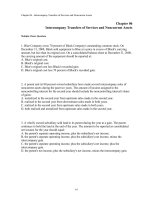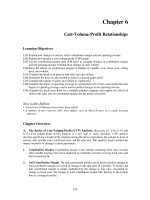Financial accounting chapter 06 inventories
Bạn đang xem bản rút gọn của tài liệu. Xem và tải ngay bản đầy đủ của tài liệu tại đây (1.45 MB, 38 trang )
6-1
Preview of Chapter 6
6-2
One Classification:
Inventory
Three Classifications:
Raw Materials
Work in Process
Finished Goods
Merchandising
Company
Manufacturing
Company
Regardless of the classification, companies report all inventories under
Current Assets on the Statement of Financial Position.
Classifying Inventory
6-3
Unit costs can be applied to quantities on hand using the
following costing methods:
Specific Identification
First-in, first-out (FIFO)
Average-cost
LO 2 Explain the basis of accounting for inventories
and apply the inventory cost flow methods.
Cost Flow
Assumptions
Inventory Costing
6-4
Illustration: Crivitz TV Company purchases three identical
50-inch TVs on different dates at costs of £700, £750, and
£800. During the year Crivitz sold two sets at £1,200 each.
These facts are summarized below.
Illustration 6-2
Inventory Costing
LO 2 Explain the basis of accounting for inventories
and apply the inventory cost flow methods.
6-5
Specific Identification
If Crivitz sold the TVs it purchased on February 3 and May 22,
then its cost of goods sold is £1,500 (£700 + £800), and its
ending inventory is £750.
Illustration 6-3
Inventory Costing
LO 2 Explain the basis of accounting for inventories
and apply the inventory cost flow methods.
6-6
Actual physical flow costing method in which items still in
inventory are specifically costed to arrive at the total cost of
the ending inventory.
Practice is relatively rare.
Most companies make assumptions (Cost Flow
Assumptions) about which units were sold.
Inventory Costing
Specific Identification
LO 2 Explain the basis of accounting for inventories
and apply the inventory cost flow methods.
6-7
Inventory Costing
LO 2 Explain the basis of accounting for inventories
and apply the inventory cost flow methods.
There are two assumed cost flow methods:
1. First-in, first-out (FIFO)
2. Average-cost
Cost flow does not need be consistent with the physical
movement of the goods.
6-8
Illustration: Data for Lin Electronics’ Astro condensers.
Illustration 6-4
(Beginning Inventory + Purchases) - Ending Inventory = Cost of Goods Sold
Inventory Costing
LO 2 Explain the basis of accounting for inventories
and apply the inventory cost flow methods.
6-9
Earliest goods purchased are first to be sold.
Often parallels actual physical flow of merchandise.
Generally good business practice to sell oldest units
first.
First-In-First-Out (FIFO)
Inventory Costing
LO 2 Explain the basis of accounting for inventories
and apply the inventory cost flow methods.
6-10
Illustration 6-5
LO 2
First-In-First-Out (FIFO)
Inventory Costing
6-11
Illustration 6-5
Inventory Costing
First-In-First-Out (FIFO)
LO 2 Explain the basis of accounting for inventories
and apply the inventory cost flow methods.
Illustration 6-6
Proof of COGS
6-12
Allocates cost of goods available for sale on the basis
of weighted-average unit cost incurred.
Assumes goods are similar in nature.
Applies weighted-average unit cost to the units on
hand to determine cost of the ending inventory.
Inventory Costing
Average Cost
LO 2 Explain the basis of accounting for inventories
and apply the inventory cost flow methods.
6-13
Illustration 6-8
Inventory Costing
Average Cost
LO 2 Explain the basis of accounting for inventories
and apply the inventory cost flow methods.
6-14
Inventory Costing
Average Cost
LO 2 Explain the basis of accounting for inventories
and apply the inventory cost flow methods.
Illustration 6-8
6-15
LO 3 Explain the financial effects of the inventory cost flow assumptions.
Financial Statement and Tax Effects
Illustration 6-9
Inventory Costing
6-16
The cost flow method that often parallels the actual
physical flow of merchandise is the:
a. FIFO method.
b. average cost method.
c. gross profit method.
d. none of the above
Question
Inventory Costing
LO 3 Explain the financial effects of the inventory cost flow assumptions.
6-17
6-18
In the first month of operations, Santos
Company made three purchases of
merchandise in the following sequence: (1)
200 units at $6, (2) 300 units at $7, and (3) 400
units at $8.
Assuming there are 300 units on hand,
compute the cost of the ending inventory
under (1) the FIFO method and (2) the average-
cost method. Santos uses a periodic inventory
system.
6-19
1. FIFO
300 × $8 = $2,400
2. Average-cost
200 × $6 = $1,200 Average-cost / unit:
300 × $7 = 2,100 $6,500 ÷ 900 = $7.22
400 × $8 = 3,200 $7.22 × 300 = 2,166
900 $6,500
6-20
Using Cost Flow Methods Consistently
Method should be used consistently, enhances
comparability.
Although consistency is preferred, a company may change
its inventory costing method.
Inventory Costing
LO 3 Explain the financial effects of the inventory cost flow assumptions.
6-21
Lower-of-Cost-or-Net Realizable Value
LO 4 Explain the lower-of-cost-or-net realizable
value basis of accounting for inventories.
When the value of inventory is lower than its cost
Companies must “write down” the inventory to its net
realizable value in the period in which the price decline
occurs.
Net realizable value refers to the net amount that a
company expects to realize (receive) from the sale of
inventory (estimated selling price in the normal course of
business, less estimated costs to complete and sell).
Inventory Costing
6-22
Illustration: Assume that Gao TV has the following lines of
merchandise with costs and net realizable values as
indicated.
Illustration 6-10
Inventory Costing
LO 4 Explain the lower-of-cost-or-net realizable
value basis of accounting for inventories.
Lower-of-Cost-or-Net Realizable Value
6-23
LO 5 Indicate the effects of inventory errors on the financial statements.
Common Cause:
Failure to count or price inventory correctly.
Not properly recognizing the transfer of legal title to goods
in transit.
Errors affect both the income statement and statement of
financial position.
Inventory Errors
6-24
Linville Company had beginning inventory on
May 1 of €12,000. During the month, the
company made purchases of €30,000 but
returned €2,000 of goods because they were
defective. At the end of the month, the
inventory on hand was valued at €10,500.
Calculate cost of goods available for sale and
cost of goods sold for the month.
6-25
Beginning inventory €12,000
Net purchases (€30,000 – €2,000) +28,000
Goods available for sale €40,000
Ending inventory –10,500
Cost of goods sold €29,500
